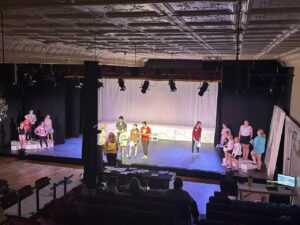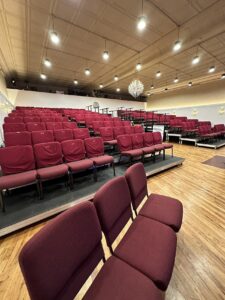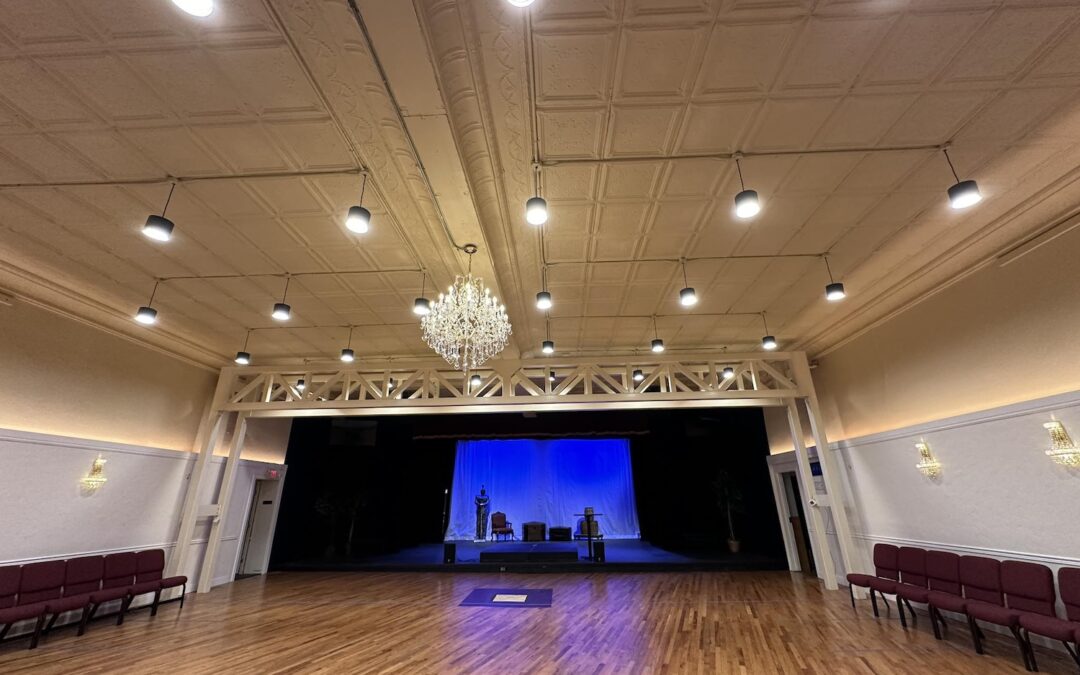A Story of Perseverance, Passion and Restoration
 In 2007, the Southern Tennessee Area Arts Repertory (STAAR) moved into an empty, yet historic, space on Pulaski’s downtown square. Formerly home to the Morris Harwell Clothing Store, this expansive building offered the theatre group an opportunity for growth after outgrowing its previous location in Lynnville in Northern Giles County. Little did they know, the move would lead to an unexpected challenge that would come to symbolize STAAR’s deep connection to the building, its history, and its future.
In 2007, the Southern Tennessee Area Arts Repertory (STAAR) moved into an empty, yet historic, space on Pulaski’s downtown square. Formerly home to the Morris Harwell Clothing Store, this expansive building offered the theatre group an opportunity for growth after outgrowing its previous location in Lynnville in Northern Giles County. Little did they know, the move would lead to an unexpected challenge that would come to symbolize STAAR’s deep connection to the building, its history, and its future.
As volunteers began transforming the space into a working theatre, they encountered a curious obstacle. In the center of the room stood a large display shelf, an artifact from the building’s retail days. Excited to open up the floor for the audience, the volunteers started to tear down the shelf, only to discover something far more complex – an iron beam stretching from floor to ceiling. This wasn’t just any beam; this was a structural support holding up Tennessee’s oldest opera house, Antoinette Hall, located directly above the space STAAR was renovating.
“We were obviously disappointed,” recalled Tammy Pierchoski, Executive Director of STAAR Theatre at Antoinette Hall. “That pole stood smack in the middle of the audience, creating visibility issues for our patrons. But we had no choice but to embrace the pole and move on.”
And embrace it they did. The beam, originally seen as a hindrance, quickly became a symbol of STAAR’s resourcefulness and determination. It became a running joke in Mrs. Pierchoski’s opening speeches before each performance. The audience would laugh along as she explained STAAR’s “love/hate relationship” with the pole – a structural necessity that both upheld Antoinette Hall and blocked perfect views of the stage below.
 A Love-Hate Relationship with History
A Love-Hate Relationship with History
This iron beam wasn’t just an obstacle; it was a vital piece of history, supporting the 1868 opera house above, which STAAR had long dreamed of restoring. Sitting on a two-foot-thick rock wall beneath the floor, the pole’s strength was impressive. It was hard to imagine how a building of this magnitude had been constructed so long ago and continued to stand today.
Over the years, STAAR consulted with engineers multiple times to explore the possibility of removing the pole, but each time, they faced the same hurdle: the cost. For a small community theatre pouring every resource into arts education, performance and making the space more comfortable for both cast and crew, removing the pole was simply out of reach.
Then, the world paused. COVID-19 shuttered businesses, theatres, and community spaces across the globe, and STAAR Theatre was no exception. But in this pause, Mrs. Pierchoski saw an opportunity. She dove into grant writing, looking for ways to improve the theatre and continue making it a space where the arts could thrive. While many grants allowed for aesthetic and functional improvements, none were available for the costly structural work necessary to remove the pole.
But fate, persistence and a bit of luck had other plans.
The Path to Funding: A Chance Encounter
While closing out a grant with the Tennessee Arts Commission, Mrs. Pierchoski learned about a new “facilities grant” designed for structural improvements. It was the break STAAR needed. Excited by the news, she immediately set to work on an application. Photos were included, showing just how the pole obstructed views. After weeks of anticipation, the news finally arrived – STAAR had been awarded $50,000 to make the dream a reality.
With funds in hand, Mrs. Pierchoski reached out to Pinnacle Industrial, Inc., a local manufacturing and industrial services company led by Tim Lochridge. Their partnership represented more than just structural work; it symbolized STAAR’s commitment to supporting local businesses and ensuring quality craftsmanship in the theatre’s long-awaited renovations.
Together, they devised a plan: two large steel posts would be placed close to the side walls, stabilizing the structure while preserving the integrity of Antoinette Hall above. These posts would be supported by massive concrete pads poured in the basement. The real stars of the project, however, were two custom-made support trusses – each weighing 3,000 pounds – fabricated to perfectly match the aesthetic of STAAR’s ceiling.
Raising the Trusses: A New Era Begins
The morning of Aug. 28, 2024, was one of anticipation and excitement. With the help of the Pulaski Police Department managing traffic, the enormous trusses arrived at STAAR Theatre. At 5 a.m., they were carefully brought into the building and hoisted into place. By 2 p.m. the following day, the STAAR team gathered inside to witness a moment that had been 17 years in the making – the lowering and removal of the pole.
Cheers and tears flowed as the iconic iron beam was finally taken down. This moment wasn’t just about the removal of an obstruction; it was about the triumph of a community that had persevered through challenges, supported the arts and dared to dream of something greater for their historic building.
But this wasn’t the end of the pole’s story.
In a fitting tribute to its significance, the pole now resides on the sidewalk outside STAAR Theatre. It has been transformed into a bench and timeline, inviting visitors to sit, reflect and imagine the countless stories the building has seen over the years. As part of Pulaski’s heritage, it will continue to serve as a symbol of strength and endurance—just as it did for STAAR.
The First Step Toward Restoration
The removal of the pole marks only the first step in a much larger plan – the complete restoration of Antoinette Hall. The new support trusses have been designed with the future in mind, forming the foundation for continued work on the opera house above.
For the STAAR team, this project represents more than just structural improvements; it symbolizes their unwavering commitment to the arts and to the community. They know that one day, they’ll stand in the fully restored Antoinette Hall, celebrating the grand re-opening of Tennessee’s oldest opera house.
Until then, the story of STAAR Theatre’s love/hate relationship with the iconic pole serves as a reminder that with perseverance, passion, and the support of a dedicated community, even the most challenging obstacles can be overcome.

